Monitoring SEO Performance: Best Tools, Metrics, and Reporting Practices
- Home
- Knowledge Sharing
- Monitoring SEO Performance: Best Tools, Metrics, and Reporting Practices
What Does SEO Performance Really Mean and How Is It Defined?
Ask ten marketers what "SEO performance" means, and you’ll get ten answers — traffic, rankings, conversions, ROI, brand exposure… the list goes on. The truth is, SEO performance is a composite concept, and understanding it requires more than staring at a single metric. So, what does it really entail?
SEO Performance: A Holistic Definition
SEO performance refers to how effectively your website attracts, engages, and converts organic search traffic, measured against business goals. It reflects:
- Visibility in search engines (are people finding you?)
- Traffic quality and volume (are the right users clicking?)
- On-site engagement (are users sticking around and taking action?)
- Conversions and outcomes (are you generating leads, sales, or sign-ups?)
Ultimately, it's about translating search visibility into tangible business value.
Four Pillars of SEO Performance
1. Visibility Metrics
This includes rankings, impressions, and share-of-voice. Tools like Google Search Console and SEMrush quantify:
- How often your pages appear in SERPs
- What keywords you rank for
- Your average position and CTR
Key Point : You can't perform well if no one sees you.
2. Traffic Metrics
From pageviews to sessions, this pillar tracks who arrives and from where. Look at:
- Organic traffic volume
- Branded vs. non-branded queries
- Traffic by landing page
Insight : A drop in traffic with stable rankings might indicate a decrease in keyword volume or seasonality.
3. Engagement Metrics
Traffic without engagement is like foot traffic in a store where nobody buys. Key engagement signals include:
- Bounce rate
- Pages per session
- Average session duration
Important : High bounce rates can reflect poor UX or mismatched search intent.
4. Conversion & Revenue Metrics
This is where SEO shows ROI. Examples:
- Leads generated
- E-commerce revenue
- Goal completions
- Assisted conversions
Google Analytics 4 and CRM integrations help tie SEO directly to business results.
Expert Insight:
In a 2023 interview with Search Engine Journal , Aleyda Solis stated:
"The best-performing SEO campaigns align metrics with real-world impact: not just traffic, but revenue, retention, and relevance."
Contextual Factors to Consider
- Industry benchmarks: A 5% CTR might be good in one niche and poor in another.
- Stage of business: A new site’s “performance” may be indexed pages, while a mature site focuses on conversion efficiency.
- Competitive environment: SERP volatility and competitive SEO efforts impact performance beyond your control.
SEO performance is not one number. It’s a symphony of signals that must be understood in context. Knowing what to measure — and what it means — is the first step to making smarter SEO decisions.
In the next section, we’ll break down the most important metrics you should track to evaluate SEO performance effectively.
What Are the Key Metrics You Should Track to Measure SEO Performance?
If SEO is a journey, metrics are your dashboard. But which ones truly matter? With so much data available, it’s easy to fall into the trap of tracking everything — and understanding nothing.
This section breaks down the core performance indicators every SEO campaign should monitor, with context, benchmarks, and use cases for each.
Why Metrics Matter
Not all traffic is good traffic. Not every ranking delivers ROI. Metrics help:
- Quantify progress
- Spot underperformance
- Align SEO efforts with business outcomes
Important : Always tie your metrics to specific objectives — awareness, lead generation, sales, or retention
Core SEO Metrics to Track
1. Organic Traffic
What it measures: Number of visitors from unpaid search.
Where to track: Google Analytics (Acquisition > Organic Search)
Benchmark: Varies heavily by industry. Focus on growth trends over fixed numbers.
Use it for : Gauging overall reach and comparing against other channels.
2. Keyword Rankings
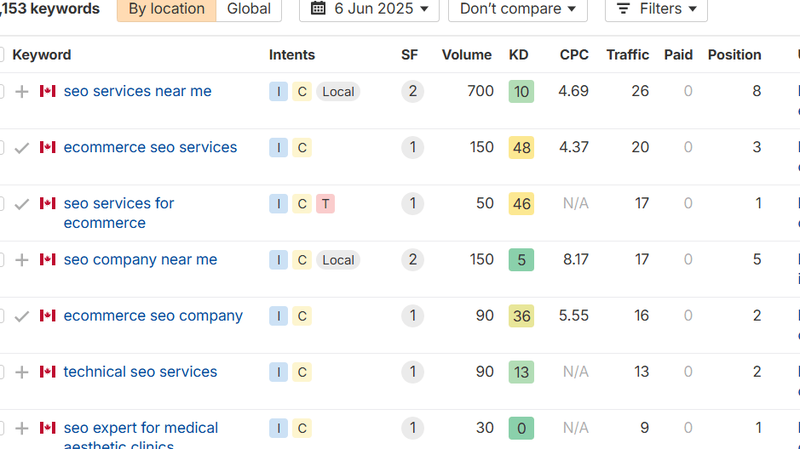
What it measures: Where your site appears for target keywords.
Where to track: SEMrush, Ahrefs, SE Ranking, Google Search Console
Benchmark: Top 3 positions get ~54% of clicks. Top 10 visibility is critical.
Use it for : Measuring visibility and finding content opportunities.
3. Click-Through Rate (CTR)
What it measures: % of searchers who clicked your result.
Where to track: Google Search Console (Performance report)
Benchmark: Avg CTR is ~3–5%, but varies by position and industry.
Use it for : Diagnosing snippet quality — titles, meta descriptions, and SERP features.
4. Bounce Rate / Engagement
What it measures: How long users stay and what they do.
Where to track: GA4 > Engagement
Benchmark: Bounce rates under 50% are generally solid.
Use it for : Identifying weak content or mismatched intent.
5. Conversions & Goal Completions
What it measures: Leads, purchases, sign-ups from organic traffic.
Where to track: Google Analytics (Conversions > Goals or Events)
Benchmark: Depends on industry. B2B forms = ~2-5%, e-commerce = 1-3%.
Use it for : Proving SEO ROI and aligning with business goals.
6. Page Load Speed / Core Web Vitals
What it measures: User experience and performance signals.
Where to track: PageSpeed Insights, Google Search Console (CWV Report)
Benchmark: LCP < 2.5s, FID < 100ms, CLS < 0.1
Use it for : Technical SEO and UX impact on rankings.
7. Backlink Quality
What it measures: Authority and trust signals from other websites.
Where to track: Ahrefs, Majestic, Moz, SEMrush
Benchmark: Aim for consistent growth in referring domains and topical relevance.
Use it for : Off-page SEO assessment and competitive benchmarking.
| Metric | Tool | Ideal Use Case | Notes |
|---|---|---|---|
| Organic Traffic | GA4, Search Console | Measuring reach | Combine with engagement + conversions |
| Keyword Rankings | Ahrefs, SEMrush | Tracking visibility | Use for SEO health reporting |
| CTR | Search Console | Improving SERP performance | Look at underperforming high-ranking terms |
| Bounce Rate / Time | GA4 | UX and intent matching | Analyze by page |
| Conversions | GA4, CRM | ROI proof | Set up goals and events |
| CWV | PageSpeed Insights, GSC | UX + technical ranking factors | Core part of Google's algorithm |
| Backlinks | Ahrefs, Moz | Authority and trust | Watch for spam links |
Don’t track metrics in isolation. Use them together to diagnose performance, build strategy, and report success.
Next, we’ll explore how to create performance-based SEO campaigns — and what you need to consider before launching one.
How Do You Set Up Performance-Based SEO Campaigns?
Traditional SEO pricing often involves fixed retainers — a monthly fee paid regardless of outcome. But in recent years, the concept of performance-based SEO has gained traction. In this model, payment is tied directly to measurable results: rankings, traffic, conversions, or revenue.
So, how do you set up a performance-based SEO campaign that’s transparent, fair, and scalable?
What Is Performance-Based SEO?
It’s an SEO model where compensation is based on outcomes instead of hours. Results might include:
- Ranking in the top 3 for target keywords
- Delivering a certain volume of organic leads
- Boosting organic traffic by X% in a set period
- Reaching agreed-upon sales figures or conversion goals
This approach shifts risk from the client to the SEO provider — so clear metrics and accountability are essential.
When to Use This Model
Performance-based SEO works best when:
- There’s a long-term agreement (6+ months)
- The site already has some baseline visibility
- The SEO agency has partial control over technical and content factors
- Both parties agree on what counts as success
It’s not ideal for:
- Brand-new websites with zero visibility
- Clients expecting instant results
- Niches with very low search volume or highly seasonal patterns
Types of Performance-Based Contracts
1. Pay-per-Rank
Payment is tied to achieving specific positions (e.g., top 3 or page 1).
- Pros: Simple to understand
- Cons: Can incentivize black-hat tactics or short-termism
2. Pay-per-Traffic
Based on increasing organic sessions over time.
- Pros: Broader metric, includes long-tail benefits
- Cons: Can be manipulated with low-quality traffic
3. Pay-per-Lead or Sale
SEO partner earns a percentage of revenue or fixed fee per conversion.
- Pros: Strong alignment with business goals
- Cons: Requires sophisticated tracking and trust
How to Set One Up (Step-by-Step)
Audit the Current Site
- Technical SEO review
- Keyword baseline
- Analytics and conversion tracking audit
Define KPIs
- Agree on targets: traffic, rankings, leads, or revenue
- Establish baselines using tools like GA4 and Search Console
Choose a Compensation Model
- Flat rate + bonus for performance
- Tiered payouts based on thresholds
Set Clear Timeframes
- Typical contracts run 6–12 months
- Include clauses for unexpected algorithm changes
Build in Transparency
- Shared dashboards or monthly performance reviews
- Source data directly from platforms (Google, Ahrefs, etc.)
Align on Control and Access
- Ensure the SEO team can edit pages, publish content, and adjust site elements
Client Examples
- A SaaS company paid $150 per qualified lead tracked via CRM, with a minimum quality threshold.
- An e-commerce brand used tiered bonuses for traffic increases: +10% = $500, +20% = $1,000, etc.
- A local service provider paid only after ranking top 5 for 15 core terms in 90 days.
| Risk | Mitigation Strategy |
|---|---|
| Traffic manipulation | Define quality standards and filter sources |
| Disputes over metrics | Use neutral third-party tools and reporting |
| Algorithm update impact | Include buffer clauses or shared risk terms |
| Lack of SEO control | Secure technical/content access upfront |
Performance-based SEO can align incentives beautifully — but only if both sides agree on data transparency, realistic goals, and shared accountability.
In the next section, we’ll look at the top tools that help monitor and report SEO performance accurately over time.
What Tools Can Help You Monitor and Track SEO Performance Over Time?
Great SEO strategies are powered by great data — but only if that data is consistent, accurate, and actionable. Whether you're running campaigns solo or for clients, using the right tools to track performance over time is essential.
Here’s a breakdown of the most effective SEO tracking tools in 2025, with a focus on their features, strengths, and how to choose the right one for your needs.
1. Google Search Console (GSC)

Best for: Monitoring visibility, indexation, and site health (free tool)
Core features:
Pros: Free, accurate, integrated with Google
Cons: Limited keyword historical depth; no competitor insights
2. Google Analytics 4 (GA4)
Best for: Measuring user behavior and conversions from organic traffic
Core features:
Pros: Robust attribution modeling; integrates with other platforms
Cons: Complex setup; learning curve for non-analysts
3. Ahrefs
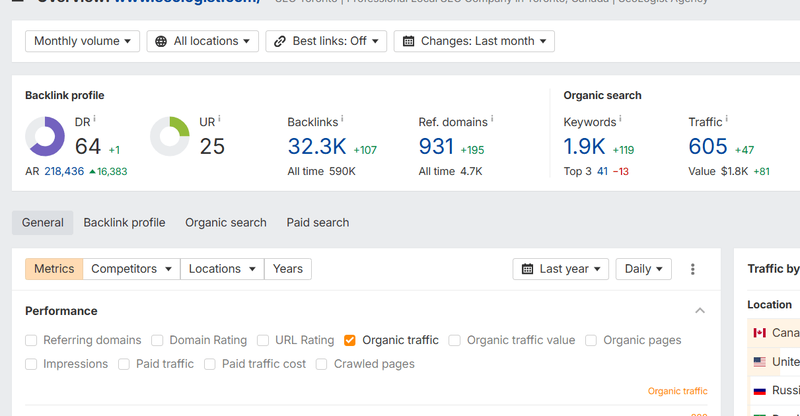
Best for: Competitive research, backlink tracking, keyword monitoring
Core features:
Pros: Industry-leading link index; excellent UI
Cons: Pricey for small businesses; no real-time tracking
4. SEMrush

Best for: All-in-one campaign monitoring and competitive tracking
Core features:
Pros: Extremely comprehensive; strong reporting tools
Cons: Interface can be overwhelming; expensive at scale
5. SE Ranking
Best for: Budget-friendly rank and visibility tracking
Core features:
Pros: High accuracy for lower price; intuitive dashboard
Cons: Lacks backlink database depth compared to Ahrefs
6. Moz Pro
Best for: Simple UI and branded reports for agencies
Core features:
- Keyword tracking with Search Visibility metric
- Link Explorer for backlinks
- Site audit with prioritization engine
Pros: Clean reports; ideal for non-technical users
Cons: Data freshness and depth can lag behind competitors
| Tool | Visibility Tracking | Rank Updates | Backlink Analysis | Technical Audit | Competitor Tracking | Price Tier |
|---|---|---|---|---|---|---|
| GSC | Yes (basic) | Daily | No | Yes | No | Free |
| GA4 | Indirect | N/A | No | No | No | Free |
| Ahrefs | Yes | Daily | Yes | Yes | Yes | $$$ |
| SEMrush | Yes | Daily | Yes | Yes | Yes | $$$ |
| SE Ranking | Yes | Daily | Yes | Yes | Yes | $$ |
| Moz Pro | Yes | Weekly | Yes | Yes | Yes | $$ |
How to Choose the Right Tool
Ask yourself:
- Do I need keyword rankings daily or weekly?
- Is competitor tracking important?
- Do I have technical expertise or need simpler dashboards?
- What’s my budget?
Tracking SEO performance is about more than just checking rankings — it’s about combining visibility, user behavior, and technical health to tell a full story. The right tools won’t just show you data — they’ll help you make better decisions over time.
In the next section, we’ll explore how often you should benchmark SEO results — and why timing matters more than you think.
How Often Should You Check and Benchmark Your SEO Results?
In SEO, timing isn’t just everything — it’s the difference between strategy and guesswork. Too frequent checks can create noise; too infrequent can let serious issues go undetected. So how often should you actually be benchmarking your SEO performance?
The answer depends on your goals, site size, and how fast your SEO activities are implemented. But some clear best practices do exist.
Daily, Weekly, and Monthly: What Should You Track?
Daily Checks (optional)
- Website uptime and critical errors (e.g., 404s, DNS failures)
- Google Search Console crawl issues (via alerts)
- Keyword volatility for priority pages (if in competitive niches)
Tools to use: Google Search Console, Ahrefs Alerts, SEMrush Position Tracking
Ideal for large, dynamic sites or when you're in an aggressive SEO phase.
Weekly Reviews
- Keyword rankings and visibility trends
- New backlinks and lost links
- Organic traffic by landing page
Why weekly? Enough time to see meaningful movement while remaining agile.
Monthly Benchmarking
- Full performance review (traffic, rankings, conversions, bounce rate)
- SEO health audit (page speed, mobile usability, indexing issues)
- Goal completions and ROI metrics
Why monthly? Combines volume with context. Great for presentations and client reporting.
| Business Type | Recommended Frequency | Notes |
|---|---|---|
| Small Local Business | Monthly | Focus on maps visibility + CTR |
| Mid-Size eCommerce | Weekly to Biweekly | Prioritize indexation and conversions |
| Large Enterprise | Daily (key KPIs), Weekly & Monthly | Dedicated SEO teams needed |
Pro Tips for Setting Your Benchmark Schedule
- Use annotations in tools like GA4 and GSC to track updates
- Align reports with campaign timelines (e.g., content launch, site migration)
- Avoid over-reacting to short-term dips — use 30-day or YoY comparisons
- Automate alerts for threshold breaches (e.g., 20% traffic drop in a week)
Sample Reporting Template
A basic monthly SEO performance report should include:
- Overview dashboard (traffic, visibility, conversions)
- Keyword ranking table (gainers and losers)
- Technical issues summary
- Content performance (top/worst pages)
- Next-step recommendations
Tip : Include visualizations to aid storytelling — graphs, trendlines, pie charts.
Checking your SEO performance too often can lead to chasing shadows; too rarely, and you risk missing out on strategic insights. Adopt a rhythm that matches your goals and resources — and stick with it long enough to spot real trends.
Next, we’ll walk through how to build SEO performance reports that clients actually understand — and care about.
What’s the Best Way to Measure SEO Success Beyond Rankings?
SEO has long been associated with keyword rankings. But as search results evolve — with featured snippets, local packs, video carousels, and AI summaries — being "#1" doesn’t always mean more clicks or revenue. In fact, focusing solely on rankings is outdated and limiting.
To measure true SEO success, you need to look beyond the SERP position and focus on what happens after someone clicks.
1. Track Conversions, Not Just Clicks
Success starts with organic visibility, but it ends with action.
Key conversion metrics:
- Form submissions
- Product purchases
- Demo requests
- Newsletter signups
- Phone calls (tracked via dynamic numbers)
How to measure:
- Use GA4 event-based tracking and custom goals
- Attribute leads or sales back to organic channels
- Break down by landing page and keyword intent
Pro tip : Use UTM parameters and CRM integrations to track full-funnel value.
2. Monitor Lead Quality
Traffic and conversions are easy to inflate. But what about quality?
Ask:
- Are these SEO leads converting to customers?
- Are they in our ICP (Ideal Customer Profile)?
- Do they stick around or churn fast?
How to assess:
- Connect SEO data to your CRM or sales platform (e.g., HubSpot, Salesforce)
- Use lead scoring to evaluate value from organic traffic
- Interview sales teams about SEO-qualified leads
3. Measure Time on Page and Engagement
If users click but bounce in seconds, your content may not match intent.
Key engagement indicators:
- Average engagement time per page (GA4)
- Scroll depth (via GTM or tools like Hotjar)
- Internal clickthrough rate (to next page or CTA)
Bounce rate alone is no longer reliable in GA4. Look at engagement metrics instead.
4. Attribute Revenue to Organic Search
This is the holy grail of SEO: proving that your efforts drive real revenue.
Ways to connect SEO to revenue:
- eCommerce sites: Set up enhanced eCommerce tracking to map product revenue to source/medium
- B2B sites: Use CRM + UTMs to track closed deals from organic leads
- Multi-touch attribution: See how SEO influences later-stage conversions
5. Track Brand Visibility and Authority
SEO success isn't always transactional. Consider:
- Brand searches increasing?
- More mentions or backlinks from reputable sites?
- Growing social shares of your SEO content?
Use tools like BrandMentions, Ahrefs, and BuzzSumo to supplement traditional metrics.
6. Measure SERP Real Estate, Not Just Rank
Modern SERPs are crowded. A #1 blue link might be buried under:
- Featured Snippets
- Video results
- People Also Ask
- Maps listings
Measure how much space your brand controls across formats. Tools like SEMrush and Ahrefs visualize this well.
Rankings are just a starting point. True SEO success lies in what comes after: user engagement, conversion, lead quality, and business growth. Shift your KPIs accordingly, and you’ll start getting more credit for what SEO really delivers.
Next, we’ll examine common tracking mistakes — and how to avoid them before they sabotage your data and insights.
What Are Some Common SEO Performance Tracking Mistakes to Avoid?
You’re collecting data, building reports, and presenting results — but something still feels off. That’s often because even skilled marketers make critical mistakes when tracking SEO performance.
These missteps don’t just cloud your insights — they can lead to bad decisions and wasted budget. Let’s break down the most common tracking mistakes (and how to avoid them).
1. Relying on Rankings Alone
Keyword rankings are volatile. They don’t tell you:
- If traffic increased
- If clicks became conversions
- Whether the searcher found what they wanted
Fix it : Combine rankings with traffic, CTR, and conversions. Always report on user behavior and outcomes, not just positions.
2. Misconfigured Google Analytics or GA4
Without properly set goals and events, you're flying blind. Common issues:
- Events not marked as conversions
- No cross-domain tracking (for subdomains or third-party tools)
- Incorrect attribution settings
Fix it : Audit your GA4 setup regularly. Use Google Tag Manager for consistent deployment. Always validate event and goal tracking.
3. Ignoring Page Speed & Core Web Vitals
You may see high bounce rates and blame content — when it’s actually load time.
Fix it : Monitor CWV in Search Console. Run PageSpeed Insights regularly. Improve LCP, CLS, and FID metrics.
4. Forgetting Mobile Performance
If your data comes from desktop-only audits, you’re missing the reality. In many industries, 70%+ of organic traffic is mobile.
Fix it : Track mobile and desktop performance separately in your tools. Prioritize mobile page UX and Core Web Vitals.
5. Reporting on Vanity Metrics
Pageviews and impressions sound great — but without context, they can be misleading.
Fix it : Tie every metric to a goal:
- Why does this metric matter?
- What action does it inform?
- Is it improving over time?
6. Overlooking Branded vs. Non-Branded Traffic
Branded traffic usually reflects existing demand — not SEO impact.
Fix it : Segment traffic in GSC and GA4. Focus SEO reporting on non-branded queries when measuring growth.
7. Comparing Incompatible Date Ranges
Looking at last 7 days vs. prior 7 days might ignore seasonality. Monthly data can skew if holidays are involved.
Fix it : Use MoM and YoY comparisons. Add annotations for major events like site migrations or algo updates.
8. Not Validating Data Across Tools
Different tools calculate visibility, rankings, and traffic differently. Blindly trusting one can create confusion.
Fix it : Cross-check GSC, GA4, and third-party tools. Build dashboards that clearly show data source and logic.
| Mistake | Why It’s a Problem | How to Fix It |
|---|---|---|
| Rankings-only tracking | Misses conversion context | Add traffic, CTR, and goals |
| GA4 misconfiguration | No conversion visibility | Use Tag Manager + audit events |
| Ignoring Core Web Vitals | Poor UX hurts SEO and users | Optimize LCP, FID, CLS |
| Mobile performance blind spots | Misleads strategy | Track mobile separately |
| Reporting vanity metrics | Misrepresents performance | Use actionable KPIs |
| No branded/non-branded split | Inflates perceived growth | Segment in GSC |
| Date range inconsistency | Misleads trend interpretation | Use MoM and YoY with context |
| Trusting only one tool | Risk of skewed insights | Cross-check multiple data sources |
The goal of SEO tracking isn’t just to collect numbers — it’s to fuel smarter actions. Avoid these common mistakes, and you’ll get clearer insights, stronger results, and better alignment with business goals.
Next up : How SEO performance ties into overall marketing ROI, and why it matters more than ever.
How Do SEO Performance Metrics Relate to Overall Marketing ROI?
It’s one thing to prove SEO is working — it’s another to show how it’s moving the needle on your business’s bottom line. Too often, SEO reports stop at traffic and rankings. But for CMOs and stakeholders, ROI is what matters most.
Let’s unpack how SEO metrics tie directly into broader marketing return on investment (ROI), and how to present that value clearly.
1. From Traffic to Revenue: Connecting the Dots
SEO is a top-of-funnel channel. But when it’s done right, it influences conversions all the way through the buyer’s journey.
Flow of SEO ROI:
- Visibility metrics (impressions, keyword rankings)
- lead to
- Traffic growth (sessions, user engagement)
- which drives
- Conversions (goals, lead forms, purchases)
- that result in
- Revenue or pipeline growth (via CRM, eCommerce platform)
Example: If SEO brings in 10,000 new visitors and 2% convert at $150 per sale, that’s $30,000 in direct revenue.
2. Multi-Touch Attribution: SEO as an Assist Channel
Most buyers interact with multiple touchpoints before converting. SEO often plays a supporting role:
- They discover your brand via search
- Return later via branded search, direct visit, or ad
- Then convert
How to track:
- Use Google Analytics’ Attribution model (linear, time decay)
- Use CRM platforms like HubSpot or Salesforce to track SEO-influenced revenue
3. SEO’s Role in Lowering CAC (Customer Acquisition Cost)
Compared to paid ads, organic traffic:
- Costs less over time
- Builds compounding value
- Has higher trust/conversion potential
Example :
Paid search CAC: $80Organic CAC (after 6 months of investment): $35
By comparing CAC by channel, you can show SEO’s long-term cost-efficiency.
4. SEO vs. Other Marketing Channels
To communicate SEO ROI in context:
- Compare conversion rates by channel (organic vs. paid vs. referral)
- Show lead quality (via CRM data)
- Map LTV (lifetime value) per channel
Tools to use: GA4, Looker Studio, Salesforce, HubSpot
Pro tip : Create a report section titled: "How SEO stacks up against other channels"
5. When SEO ROI Doesn’t Show Up Immediately
SEO is a long-term play — so ROI takes time. This doesn’t mean it’s not delivering value. Show:
- Content velocity (pages indexed per month)
- Keyword visibility gains
- SERP features captured (Featured Snippets, Local Pack)
- Long-term traffic growth trendlines
6. Presenting SEO ROI to Executives
Keep it simple, outcome-driven, and visual:
- SEO investment (hours, spend)
- ROI impact (revenue influenced, CAC drop, lead volume)
- Forecasted gains (projected traffic/conversions)
Executive-friendly KPIs:
- SEO-generated revenue (or influenced pipeline)
- ROI ratio (revenue/spend)
- Organic conversion rate
- Keyword share of voice
SEO metrics are not just tactical indicators — they’re strategic drivers of ROI. When you connect performance data to revenue, cost savings, and pipeline growth, SEO becomes a boardroom priority — not a line item to cut.
Up next: Can your SEO performance tracking be automated? Let’s look at the tools and tactics that make it scalable.
Can You Automate Your SEO Performance Monitoring Process?
Manually tracking rankings, traffic, and conversions every week? That doesn’t scale. Automation isn’t just a time-saver — it ensures consistency, speed, and early warnings.
Let’s explore how to automate your SEO performance monitoring without losing clarity or control.
1. Dashboards: Your Always-On SEO Command Center
Create a real-time view of key metrics:
Tools to use:
- Looker Studio (Google Data Studio): Connect GA4, GSC, Ahrefs, SEMrush
- AgencyAnalytics / DashThis: Templates for white-labeled client dashboards
- GA4 Explore Reports: Custom event funnels and dimensions
Pro tip : Include charts for traffic, rankings, conversions, CWV, and backlinks. Set up filters by landing page or device.
2. Automated Alerts: Know Before the Client Does
Configure alerts that trigger when metrics deviate from expectations.
Common alert scenarios:
- Organic traffic drops 20% in a week
- Ranking for high-value keyword falls 5+ positions
- Core Web Vitals drop below passing thresholds
How to do it:
- Google Analytics custom alerts
- SEMrush/Ahrefs position drop alerts
- Slack + Zapier for notifications
3. Scheduled Reports: Set It and Forget It
Deliver weekly or monthly reports via email with updated charts.
Use cases:
- Client-facing performance summaries
- Internal SEO health snapshots
- Quarterly trendline overviews
Tools:
- Looker Studio (scheduled exports)
- Moz Pro and SEMrush PDF reporting
- Supermetrics (for spreadsheets and dashboards)
4. Keyword Monitoring Automation
Track your keyword sets across locations, devices, and SERP features — automatically.
Tools:
- Ahrefs (Rank Tracker)
- SEMrush (Position Tracking)
- SE Ranking (Daily position updates)
Bonus Tip : Add tags (e.g., "high-intent," "branded") for grouped reporting.
5. Backlink Monitoring & Alerts
Set up alerts for new/lost links and toxic domains.
How:
- Ahrefs or Moz: New link email reports
- Monitor Backlinks: Risk scoring
- Google Search Console: Manual actions alerts
6. Crawl Health & Technical SEO Checks
Rather than wait for a quarterly audit, automate crawl diagnostics.
Recommended tools:
- Screaming Frog (scheduled crawls + Google Sheets export)
- Sitebulb (task automation + change detection)
- JetOctopus for enterprise sites
7. Use AI for Anomaly Detection
Modern SEO platforms now include AI-based insights to detect ranking volatility, traffic spikes, or technical regressions.
Examples :
- Surfer SEO’s Grow Flow
- SEMrush Sensor (SERP turbulence monitor)
- Ahrefs Alerts
Implementation Tips
- Don’t automate without strategy: Know what you’re tracking and why
- Balance automation with manual review: Check anomalies before reacting
- Avoid over-alerting: Set thresholds that reflect business impact
Automation doesn’t replace strategy — it enhances it. With the right setup, your SEO monitoring becomes more efficient, accurate, and proactive. You’ll spend less time compiling reports and more time making smart, high-impact decisions.
Next, we’ll show you how to check a competitor’s SEO performance — without crossing ethical lines.
How Can You Check the SEO Performance of a Competitor’s Website?
Want to know what’s driving a rival’s organic growth? Competitor SEO analysis isn’t about copying — it’s about discovering content gaps, backlink opportunities, and benchmarking your visibility.
The key is to do it ethically, strategically, and using the right tools.
1. Analyze Their Organic Traffic Trends
Start with traffic estimates:
Tools to use:
- SEMrush (Domain Overview > Organic Research)
- Ahrefs (Site Explorer > Organic Search)

- SimilarWeb (for industry-wide benchmarks)
Check:
- Monthly organic traffic estimates
- Traffic trendlines (YoY)
- Top-performing pages
Tip : Compare their organic traffic trajectory to your own — is it seasonal or steadily growing?
2. Identify Their Top Keywords
What queries drive their visibility?
Steps:
- Enter competitor domain in SEMrush or Ahrefs
- Sort keywords by traffic or position
- Export keywords ranking in top 10
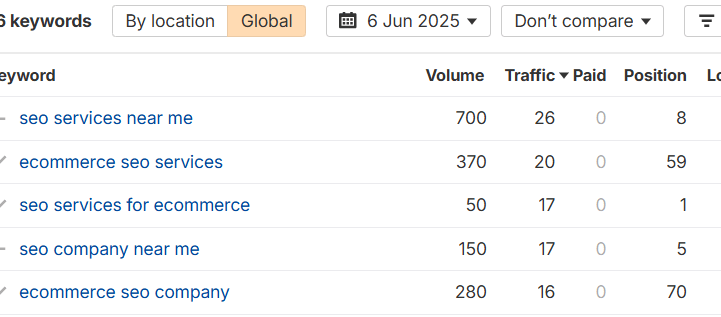
Segment by:
- Branded vs non-branded terms
- Commercial vs informational intent
- SERP features (featured snippets, video, images)
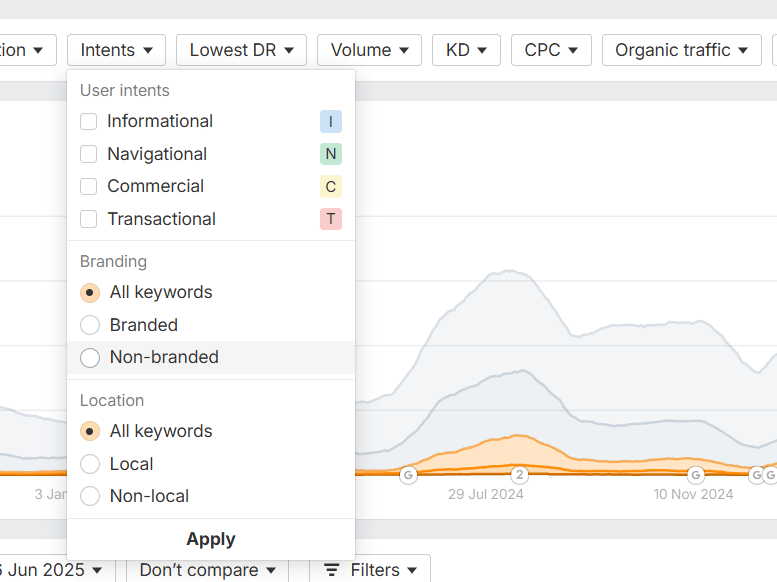
3. Analyze Their Content Strategy
Find:
- Which pages generate the most traffic?
- Are they using cluster structures (pillar + support)?
- Which blog posts earn backlinks?
Tools:
- Ahrefs > Top Pages

- BuzzSumo (for most shared content)
- Screaming Frog (crawl their blog for content depth, metadata)
Look at title tags, H1s, and internal links — these reveal their prioritization.
4. Review Their Backlink Profile
Backlinks remain a top ranking factor. Discover where competitors are earning links.
Tools:
- Ahrefs > Backlinks > Referring Domains
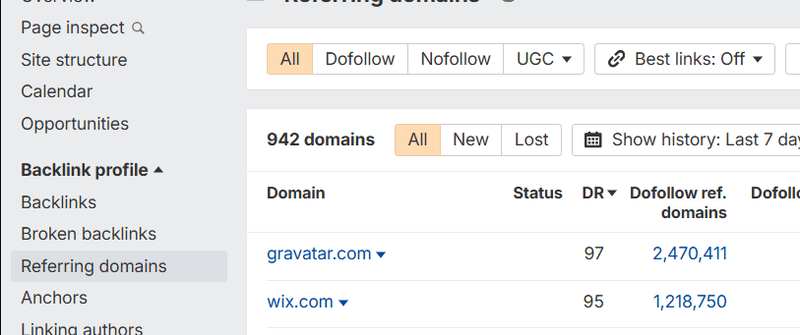
- Moz Link Explorer
- SEMrush > Backlink Analytics
Sort by:
- Domain Authority (DA)
- Industry relevance
- Anchor text used
Opportunity: Find backlinks they have — but you don’t.
5. Compare Technical SEO Health
Run a crawl to identify issues or advantages:
- Site speed
- Mobile-friendliness
- Indexation setup
- Core Web Vitals
Tools:
- Sitebulb or Screaming Frog crawl
- PageSpeed Insights
- GSC URL Inspection Tool (for shared pages, if public)
6. Track Their SERP Features & Share of Voice
Modern SERPs offer more than blue links. Are they capturing:
- Featured snippets?
- People Also Ask?
- Local map pack?
- Video thumbnails?
Tools:
- SEMrush > SERP Analysis
- Ahrefs > SERP Overview
- MobileMoxie (to simulate different devices/locations)
7. Watch Their SEO Activity Overtime
Set alerts for content changes, new links, or rank gains:
- Visualping or Hexowatch (track content edits)
- Ahrefs Alerts (new backlinks)
- SEMrush Projects (site audit + keyword tracking)
Ethical Considerations
- Never scrape private data or force access
- Don’t duplicate exact content or structure
- Use findings to inform — not mimic
Competitor SEO analysis is one of the highest ROI activities in modern SEO. It shows you what works, what’s overdone, and where your unique opportunities lie.
Next, we’ll cover what questions to ask during an SEO audit — and how those questions can uncover invisible performance issues.
What Questions Should You Ask During an SEO Performance Audit?
A good SEO audit doesn’t start with tools — it starts with smart questions. The right questions help uncover not just what’s broken, but why performance is stuck or declining.
Here’s a framework for the critical questions to ask when conducting a full SEO performance audit.
1. Is the Site Being Indexed Properly?
Start with crawlability and indexation.
Ask:
- Are all core pages indexed in Google?
- Are there unnecessary pages being indexed (e.g., tag archives, test URLs)?
- Are key pages blocked by robots.txt or meta noindex?
How to check: Google Search Console > Coverage + URL Inspection
2. Are There Technical Issues Hurting Rankings?
Technical SEO underpins everything else. Ask:
- Is the site mobile-friendly?
- Are Core Web Vitals passing?
- Are there broken links or redirect chains?
- Is the sitemap submitted and clean?
Tools: Screaming Frog, PageSpeed Insights, Sitebulb
3. Are the Keywords Targeted Aligning with Intent?
You can rank well for the wrong things. Ask:
- Are we targeting the right terms at the right funnel stage?
- Is keyword cannibalization happening?
- Are high-potential queries missing from the strategy?
Check: Use GSC queries report + Ahrefs/SEMrush keyword gaps
4. How Are Key Pages Performing?
Don’t just look at site-wide metrics. Zoom in on:
- Top landing pages: are they improving or dropping?
- Conversion pages: do they get enough SEO traffic?
- Product/category pages: are they cannibalizing each other?
Tools: GA4 > Landing Pages, GSC > Pages
5. Is the Content Updated, Unique, and Useful?
Content decay kills rankings. Ask:
- Are top pages updated in the last 12 months?
- Are there duplicate content risks (internal or external)?
- Do pages match user intent and search format (e.g., listicle, how-to)?
Tools: Siteliner, Surfer SEO, manual review
6. Is Internal Linking Helping or Hurting?
Internal links shape crawl paths and authority flow.
Ask:
- Are top pages being linked from key hubs?
- Is anchor text optimized or too repetitive?
- Are orphan pages hurting indexation?
Tool: Screaming Frog > Crawl Visualizations
7. How Is the Backlink Profile Trending?
Authority still matters. Check:
- Are we gaining or losing quality links?
- Any spammy links needing disavow?
- Which pages attract backlinks naturally?
Tools: Ahrefs, Moz, SEMrush backlink reports
8. Are There UX or Conversion Issues?
Traffic without conversion is wasted.
Ask:
- Is the site structure confusing?
- Are CTAs visible and compelling?
- Are users bouncing too fast?
Tools: GA4 engagement data, Hotjar session recordings
9. What Has Changed Recently?
Algorithm updates, site migrations, CMS changes — all impact SEO.
Ask:
- Were major changes annotated in GA or GSC?
- Did rankings drop after a specific event?
- Has hosting or URL structure changed?
Fix: Create a change log going forward
10. Is Performance Improving YoY or MoM?
SEO is long-term. Ask:
- Are we growing compared to last month/last year?
- Are we gaining market share?
- How does our visibility compare to competitors?
Use: Looker Studio trendlines, GSC filters, SEMrush domain comparisons
SEO audits are only as good as the questions behind them. By starting with clear, diagnostic questions, you go beyond surface-level issues and find the real levers of performance.
Next, we’ll look at the difference between one-time performance checks — and continuous SEO monitoring, where the real competitive edge lives.
What’s the Difference Between Checking SEO Performance vs. Monitoring It Continuously?
Running a quick check on SEO metrics is useful — but continuous monitoring is how you win long-term. Many brands confuse these two approaches, leading to reactive strategies and missed growth opportunities.
So, what’s the difference? And why does it matter?
SEO Performance Checks: Snapshots in Time
SEO performance checks are typically manual, periodic reviews that answer, “How are we doing right now?”
Characteristics:
- Run monthly or quarterly
- Often tied to reports or campaigns
- Focus on short-term KPIs: rankings, traffic, conversions
- Limited visibility into anomalies or trends
When useful:
- Post-campaign review
- Budget reviews
- Executive reporting
Think of it as checking your vitals at a doctor’s visit.
Continuous Monitoring: Always-On SEO Awareness
Continuous monitoring involves ongoing data collection and alert systems that flag changes — as they happen.
Characteristics:
- Automated or semi-automated
- Real-time alerts for traffic drops, indexation issues, ranking volatility
- Informed by multiple sources: GA4, GSC, Ahrefs, PageSpeed, uptime tools
- Better for catching issues before they snowball
When useful:
- Site migrations
- Algorithm updates
- E-commerce seasonal fluctuations
More like wearing a fitness tracker that updates you hourly.
| Aspect | Performance Check | Continuous Monitoring |
|---|---|---|
| Frequency | Monthly/quarterly | Daily/real-time |
| Tools used | Dashboards, spreadsheets | Alerts, API integrations, crawlers |
| Purpose | Report on status | Detect anomalies early |
| Resource intensity | Lower (short bursts) | Higher (but automated) |
| Ideal for | High-level strategy review | Technical SEO and fast-moving sites |
Why It Matters for SEO Strategy
If you only check performance occasionally, you risk:
- Missing technical regressions
- Overlooking slow traffic declines
- Reacting too late to algorithm shifts
With continuous monitoring, you can:
- Catch and fix errors within days, not months
- Optimize incrementally based on live trends
- Provide better client or team transparency
Tools That Support Ongoing Monitoring
- SEMrush: Position tracking + alerts
- Ahrefs: Alerts for keyword, backlink, and SERP changes
- Looker Studio Dashboards: Live GA4 + GSC data
- JetOctopus / Screaming Frog: Scheduled crawls
- Slack + Zapier + Webhooks: Push alerts into your workflow
SEO performance checks are essential — but they’re not enough. To stay ahead of competitors, algorithm updates, and user behavior shifts, continuous SEO monitoring is the real advantage.
Next up : how to adapt your SEO strategy based on the performance data you uncover — turning metrics into moves.
How Should You Adjust Your SEO Strategy Based on Performance Data?
You’ve collected the data — now what?
That’s where strategy enters. Data is only powerful when it informs what you do next. Whether you’re facing a traffic plateau, ranking drop, or surprising content win, performance metrics should guide strategic pivots.
Here’s how to turn insight into action.
1. If Rankings Are Up but Traffic Isn’t
Sometimes you rank higher but don’t see traffic gains. Why?
Possible causes:
- Low CTR due to poor meta titles/descriptions
- Featured snippets or ads pushing you down visually
- Wrong intent match (ranking for the wrong queries)
Adjustments:
- Rewrite metadata for clarity and appeal
- Check SERP layout for visibility challenges
- Align page content with user intent and SERP format
2. If Traffic Is Up but Conversions Are Flat
More visitors without more leads = a friction point.
Likely issues:
- Poor CTA placement or clarity
- Misaligned audience (wrong keyword targeting)
- Slow or mobile-unfriendly page design
Tactical fixes:
- Heatmap tools (e.g., Hotjar) to find where users drop off
- Test new CTA wording/designs
- Improve content relevance and page speed
3. If Backlinks Are Growing But Rankings Aren’t
Authority is growing — but not reflected in SERPs?
Look deeper:
- Are links pointing to the right pages?
- Is technical SEO holding the site back?
- Are top competitors earning even more links?
Solutions:
- Create internal links from high-authority pages to targets
- Fix crawl/indexation issues
- Use Ahrefs/SEMrush to compare link velocity with rivals
4. If Certain Pages Outperform Others
Learn from winners.
Review top content for:
- Structure (headings, readability)
- Intent match
- Internal/external links
- Content freshness
Then replicate success:
- Update underperforming pages with similar structure and intent
- Expand topics into clusters
- Promote top content more broadly
5. If You See Sudden Drops or Spikes
SEO volatility is common, but don’t panic — investigate.
Use this triage checklist:
- Was there a Google algorithm update?
- Were there site changes (URL, layout, redirects)?
- Has your content been copied or penalized?
React accordingly:
- Check GSC for indexation or coverage issues
- Annotate timeline with recent changes
- Perform a technical audit if unresolved
6. Regularly Revisit Keyword Targeting
Search trends change — and so should your keywords.
Evaluate:
- Are you still ranking for the terms that matter?
- Has search intent evolved?
- Are there new competitors dominating SERPs?
Use tools: Google Trends, AnswerThePublic, Ahrefs keyword movements
7. Turn Data Into Hypotheses and Tests
Performance data should lead to experiments:
- Test new title tag formats
- A/B test intro paragraphs for bounce reduction
- Try schema markup for enhanced SERP visibility
Track outcomes — and if they work, scale.
SEO performance data is a compass, not a scoreboard. Every insight should trigger a strategic adjustment — no matter how small. The best SEO teams aren’t just analysts. They’re decision-makers.
Next : we wrap it all up with best practices for long-term SEO growth — metrics, mindset, and monitoring combined.
Conclusion: Best Practices for Long-Term SEO Performance Growth
You’ve tracked, measured, analyzed, and adjusted. But the truth is — SEO is a game of ongoing refinement, not one-time wins.
So how do you build an SEO program that compounds results over time, survives algorithm updates, and continues to deliver ROI?
Here’s a summary of best practices every SEO team should implement.
1. Always Tie Metrics to Business Goals
Organic sessions are nice. Revenue is better.
Ensure your metrics ladder up to real business outcomes:
- Leads generated from SEO
- Sales/conversions with organic attribution
- Customer LTV by acquisition source
Use GA4 + CRM data to close the attribution loop.
2. Monitor the Right KPIs — Consistently
Choose a consistent set of KPIs for weekly/monthly reporting. Include:
- Organic sessions and conversions
- Top landing pages by traffic and goal completions
- Keyword visibility and share of voice
- Core Web Vitals and site health metrics
Use dashboards to visualize trends — not just numbers.
3. Build for Users, Optimize for Search Engines
Google doesn’t buy from you — people do.
Prioritize:
- Fast, mobile-friendly, accessible pages
- Clear navigation and CTAs
- Helpful, original, high-quality content
SEO growth follows when user experience leads.
4. Automate What You Can, Review What Matters
Save time on repetitive tasks:
- Automate rank tracking and alerts
- Schedule performance reports
- Run regular crawls and CWV checks
But always review anomalies and critical shifts manually.
5. Keep Your SEO Stack Clean
Don’t overcomplicate. Use 3–5 core tools well:
- GA4
- GSC
- Ahrefs/SEMrush
- Screaming Frog
- Looker Studio
Document your tool stack and SOPs so your team stays aligned.
6. Make SEO a Cross-Team Sport
Your devs, content writers, and marketing managers all influence SEO.
Create alignment via:
- Monthly SEO sync meetings
- Shared dashboards
- Content/tech planning sessions
Long-term SEO performance is stronger when cross-functional teams are involved.
7. Stay Adaptive — and Humble
Search is always changing.
- What works today may not work next quarter
- Algorithm changes will disrupt your wins
- User behavior shifts fast (thanks, AI)
Be ready to pivot. Run tests. Never assume.
| Element | Why It Matters | Tool/Tip |
|---|---|---|
| KPI dashboard | Consistent reporting + visibility | Looker Studio |
| Conversion tracking | Links SEO to revenue | GA4 + CRM |
| Crawl health monitoring | Prevents invisible site errors | Screaming Frog, Sitebulb |
| Content update calendar | Keeps top URLs fresh and competitive | Notion, Trello |
| Algorithm update log | Correlate traffic drops with real events | Google updates + annotations |
| SEO strategy reviews (quarterly) | Realigns tactics with trends and results | Internal review meetings |
Final Thought
Long-term SEO performance isn’t about one strategy — it’s about building a system that evolves with data, user needs, and search behavior. Track the right things. Act on the right signals. Collaborate across teams.
That’s how you turn SEO from a channel — into a growth engine.
FAQ
How can I run a quick SEO performance check on my website?
Use Google Search Console to review index status, top queries, and coverage issues. Pair it with GA4 for traffic and engagement data. For a rapid audit, try tools like Screaming Frog or Ahrefs Site Audit to scan for errors, broken links, and on-page SEO gaps.
What’s the best method to measure SEO performance for a new site?
Start with the basics: ensure your site is indexed in Google Search Console, then track impressions and clicks from day one. Monitor keyword visibility with SEMrush or Ahrefs, and set up GA4 to capture goal completions and bounce rates. Focus on early indicators like crawl activity, ranking for branded terms, and initial organic sessions.
Is monitoring SEO performance enough to guarantee results?
No — monitoring is essential, but not sufficient. You need to analyze what the data reveals, test strategic changes, and iterate regularly. Without adjustments based on insights, monitoring becomes passive observation, not active improvement.






